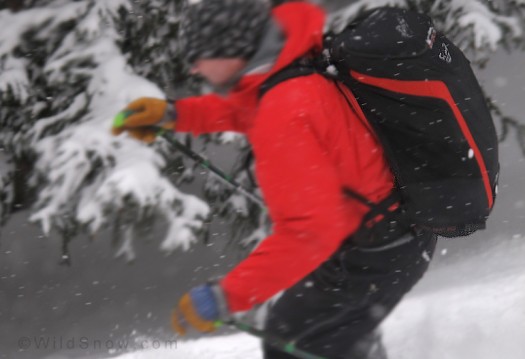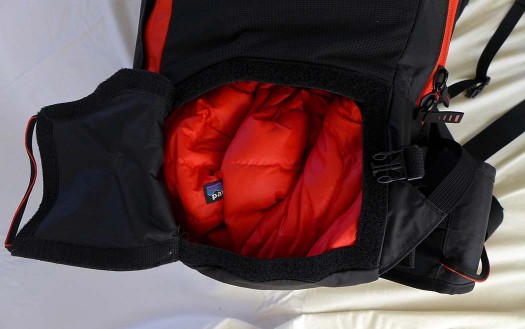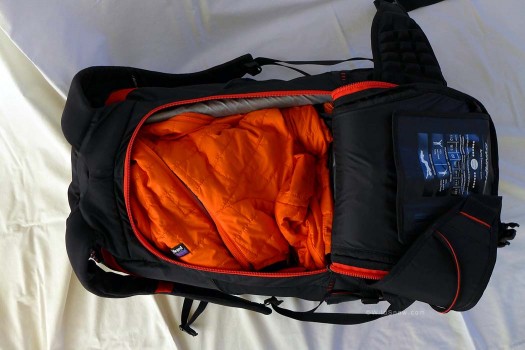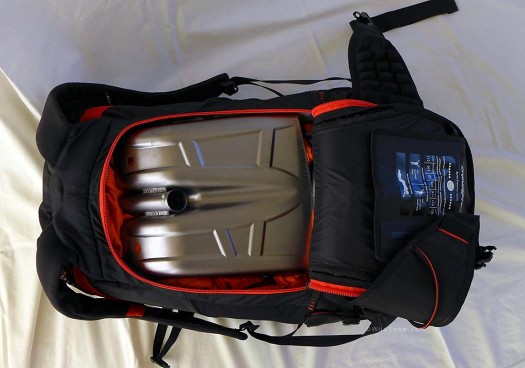Michael Kennedy
For years I subscribed to the idea that one should own a single pack for climbing (winter and summer) and backcountry skiing. That meant a top-loader with about a 50-liter capacity to fit all the ropes, hardware and other junk required for ice climbing, compression straps to reduce the volume as needed, and a minimum of extra pockets and other doo-dads.
I gradually came to accept the idea of owning a few more specialized packs for different activities, although I continued to basically throw everything into a big sack and root around (or dump it out) to find what I needed. The past few winters, though, a newer breed of lightweight, backcountry-ski-specific packs seemed to offer significant advantages in terms of weight, comfort and function. Intrigued, I figured I’d check out the Dynafit Cho Oyu 35.
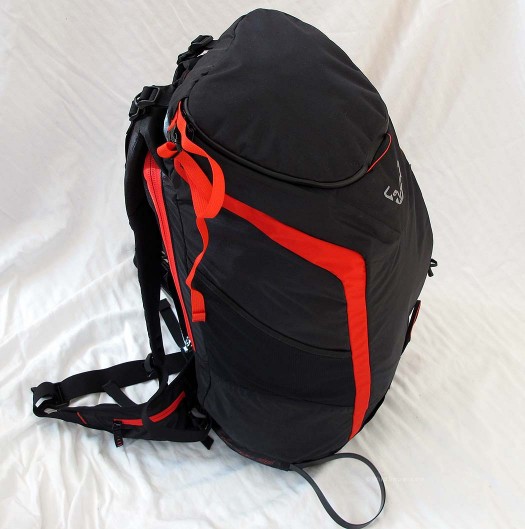
Ski carrying system and ice axe holder tuck away when not in use; handy skin pocket is easily accessed in the field. Skins can also be stuffed in the deep external mesh pocket on the left side of the pack. Note the ski carrying system includes a strap and 'hook' mounted on the right shoulder strap, typical of all Dynafit and many other European brand ski touring packs.
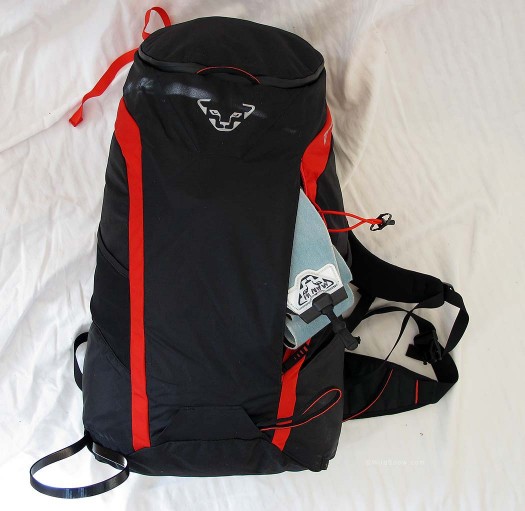
Zippered skin pocket keeps your fur separate from other goods. Ski loop (lower left) is adjustable. Agile users can mount skis without removing the pack.
One of the first things I noticed was the Cho Oyu weight, or lack thereof. My one-size-fits-all 50 liter pack weighs 1660 grams/58.5 ounces, while my slightly smaller 45 liter pack tips the scale at 1616 grams/57 ounces. Cho Oyu 35 weighs 1226 grams/43.2 ounces from the factory (I leave the insulated Summit-Comfort cushion and the shoulder strap mounted bottle holder at home, saving an additional 110 grams/3.9 ounces). The weight saved over my other packs is significant. And the 35-liter capacity Cho is totally adequate for day tours if a bit tight for a hut trip — just make your partner carry the wine.
Comfort, “ski-ability” and easy access to the essentials are where the Cho Oyu 35 really shines. The lightly-padded shoulder straps, waist belt and foam/aluminum tube frame system spread the load effectively. With the modest amount I generally carry for mid-winter tours in Colorado — less than 20 pounds including food and water — I barely noticed the Cho Oyu 35 on my back. (Throw in another 15 pounds of food for a hut trip and you’ll start to feel it, so I’d switch to a bigger pack with a more robust suspension system for loads approaching 40 pounds.)
I tried the Cho Oyu 35 both with and without the easily-removed aluminum frame. Without, you save a little weight (70 grams/2.5 ounces) and the foam back panel folds out of the way, making for even more convenient packing. In the end, though, the frame improves the carry enough to be worth keeping. Note that most people will want to custom-fit the frame; simply bend to more closely mimic the curve of your back and re-install.
Panel-loading of the Manaslu 35 is a favorite feature. It is far easier, in the field, to find what you are looking for, a revelation for someone used to rummaging around in a top loader. What’s more, the relatively small size and minimalist design of the Cho Oyu 35 forced me to both rethink what I was carrying and to exhibit greater discipline in how I packed.
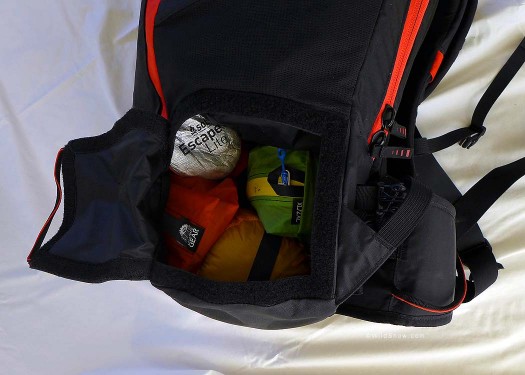
Packing for a typical mid-winter Colorado ski tour. Bottom “Safety Box” (viewed from the side in this photo) compartment for lesser-used items: repair and first aid kits, lightweight bivy sac and puff pants for emergencies. Note the Safety Box is also intended for things like quick access to a rope or crampons if you're dealing with technical travel, idea being you can reach back and pull out your rope without removing the pack, ditto for your spikes.
My new approach to packing is still a work in progress. But for now I’ve streamlined and updated my first aid and repair kits, further refined my clothing and glove systems, and have generally pared down what I carry.
Key is to pack so the weight is low and close to your back. My lesser-used and heavier items fit nicely in the bottom “safety box” compartment, accessed by the Velcro flap on the side. Everything else goes in the main compartment and the voluminous top flap. Items I really need are easy to get to. The bucket-shaped top compartment of the Cho Oyu is especially good for goggles, sunglasses, sunscreen—-all the little things that tend to get lost in a larger compartment.
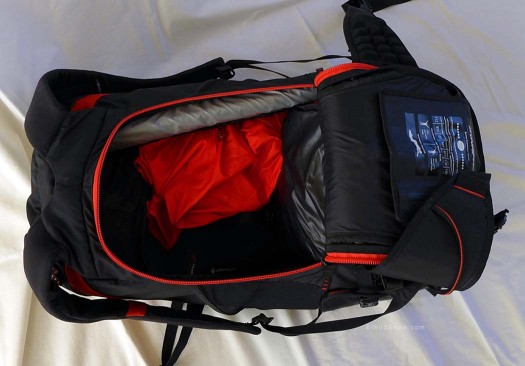
Main compartment, panel loading flap open (aluminum tube frame has been removed so the back panel can be folded out of the way for clarity). Probe and shovel handle ride in horizontal fabric tube visible at top.
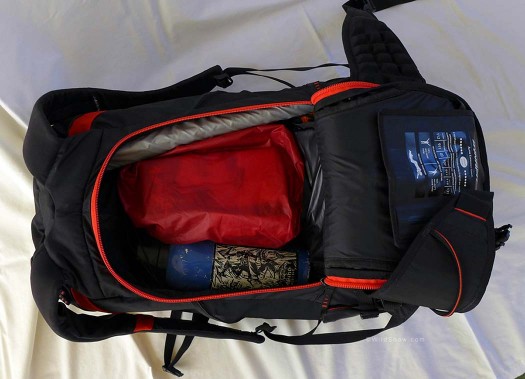
Lightweight items—-shell and warm mitts--towards the outside, heavier thermos/water bottle and food bag next, insulated and nestled in a puffy outer layer. Shovel blade fits on top.
Probe and shovel handle slide into a sleeve accessed through the Cho Oyu top flap. The shovel blade lies flat against items packed in the main compartment — you’ll want a small-to-medium blade like the Backcountry Access B-1 or B-2 for the best fit. It’s a minor inconvenience to remove the shovel blade to access the main compartment, and you won’t want to space it out when you pack up after lunch. Not a big deal from my perspective but some may miss a dedicated shovel pocket.
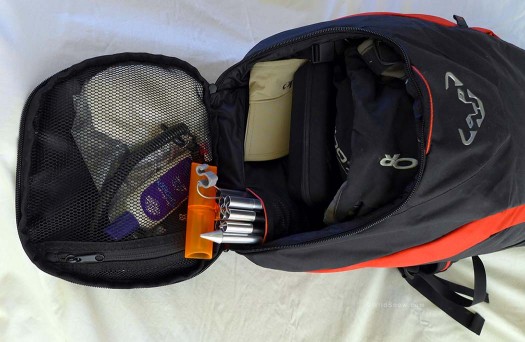
Bucket-shaped top compartment works well for goggles, sun glasses, lightweight gloves, visor, sunscreen, etc. Probe and shovel handle slide nicely into built-in sleeve. Note that none of this is packed very tight, there is still plenty of room for extra layers, another pair of gloves, etc.
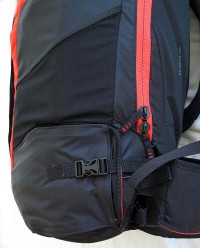
WildSnow.com, "everything shall be modified." In this case, safety buckle on the Safety Box. Another method is to thread the shoulder strap (visible) though the Safety Box pull loop. Click image to enlarge.
Minor mod and a few cons: The Velcro flap on the “Safety Box” blew open a few times, probably due to inattention on my part. I never lost anything, but I added a buckle to make it bombproof. The closure is now much more secure but still convenient to access. For those adverse to sewing, you can “safety” the Safety Box flap by threading the shoulder strap through it. Only other mod I can think of is I’d love to see Dynafit add lightweight (optionally removable) side compression straps to the Cho Oyu 35. I haven’t missed compression straps all that much, and have come to appreciate the clean, no-frills exterior. But when the pack is lightly loaded it tends to move around a bit without a way of stabilizing the load. One small gripe is the tiny “sunscreen pocket” on the waist belt. It’s so small and mounted so far back it’s nearly impossible to access while you’re wearing the pack. Also, note that some etailer specifications state this pack has “rope attachment eyelets.” We couldn’t find any such thing, though we’d like to have them.
Overall, this a truly excellent backcountry skiing backpack. WildSnow many thumbs up!
Shop for Dynafit Cho Oyu backpack rucksack. (Reasonably priced, in our opinion.)
(Michael Kennedy probably needs no “Guest Blogger bio,” but for those of you wondering: Longtime (former) owner and publisher/editor of Climbing Magazine, former editor of Alpinist Magazine, pioneer alpinist, longtime pro photographer. And yes, ski mountaineer of many decades… There you go.)
Beyond our regular guest bloggers who have their own profiles, some of our one-timers end up being categorized under this generic profile. Once they do a few posts, we build a category. In any case, we sure appreciate ALL the WildSnow guest bloggers!

